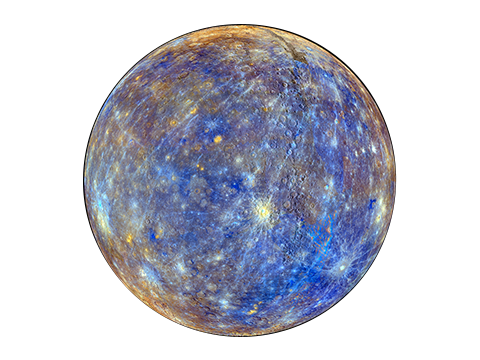Mercury Facts
Planet Profile
| Type | Terrestrial |
| Age | 4.503 billion years |
| Length of Year | 0.240846 Earth year |
| Satellites | 0 |
| Radius | 1,516 mi |
| Mass | 3.3011×1023 kg |
| Volume | 6.083×1010 km3 |
| Orbit Speed | 47.362 km/s |
| Dist. from Sun | 46 to 70 million km |
Below are some of the facts about Mercury:
- Mercury is the first planet in the solar system, which is nearest to the sun, and it is the smallest of the 8 planets in the system.
- Mercury has been mentioned about first times in recorded history by the Sumerians in the 3000 BC. It was only in 1543 that mercury got identified as a planet by astronomers.
- Mercury completes a spin around its axis in 176 number of earth days, which mean 176 x 24 hours.
- Mercury completes a year in 88 days. This means the planet takes 88 mercury days to complete one full rotation round its orbit.
- Diameter of mercury is 4879 km, and it is visible to the naked eye without any telescope.
- The composition of mercury includes rocks and heavy metals. This makes mercury the next densest planet in the solar system after earth.
- Mercury does not have an atmosphere. Whatever gases are accumulated on its surface gets swept off and blown away by powerful solar winds, which in turn again fill the gap with other gases, radioactive decay particles, and cosmic dusts.
- Mercury has much lower gravity than that of earth. It has only 38% gravity than that of the earth.
- It’s because of the lack of enough gravity that mercury has no rings or moons around it.
- Mercury, although the closest planet to the sun, is not the hottest planet in the solar system. Rather the hottest planet is Venus. Mercury gets heated up during the day, but releases that heat at night due to lack of atmosphere and heat trapping gases around it.
- The planet is tilted the least to its axis among all other planets. Due to the lack of much tilt, there are so seasons in mercury.
- The rotation of mercury is not restriction to one rotation per year. In fact it rotates thrice for every two orbits of the sun, which is because of the tidal locking force of the sun on it.
- Compared to the iron core of earth which has a core volume of 17% of earth’s volume, the core volume of mercury is larger and 40% of its volume. It’s believed that the core contains molten iron.
- The outer shell or crust of Mercury is 500 to 600 km thick.
- Mercury is full of craters which are impact marks from comets and meteors. The surface looks a lot like moon, and the largest crater called Caloris Basin is 1550 km, which was reported by the spacecraft Mariner 10.
